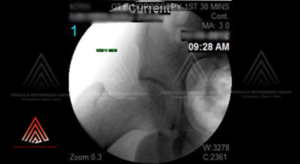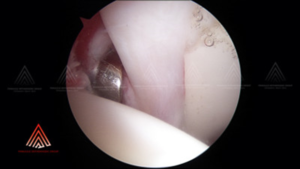
The hip joint is a ball (femoral head) and socket (acetabulum) joint. It is a highly congruous joint, and deeply seated within multiple layers of thick overlying muscles, making access to the hip joint more difficult than most joints. Until recently, gaining surgical access to the hip joint has always required open surgery to cut through thick layers of muscles and surgical dislocation of the hip just to treat hip problems. Many of the surgeries involving the hip joint have also been largely limited hip replacement surgery to treat end-stage hip arthritis or osteoporotic hip fractures.
Hip arthroscopy is the use of a keyhole, minimally invasive surgical technique to treat injury and disorders of the hip. The advantage of arthroscopy is the avoidance of a formal open surgery. This technique is technically demanding, and only a few surgeons in Singapore are formally trained to do this procedure safely. It requires special equipment and an intensive surgical set-up. Because of its highly congruous nature, the hip requires distraction for these key-hole instruments to gain access into the joint. Similarly, because it is a deep-seated joint, radiological guidance is needed to guide these instruments safely into the hip without the need of formal open incisions.




Not all hip conditions can be treated using this key-hole technique. Suitable conditions include, but are not limited to, the presence of loose bodies causing locking of the hip; cartilage or labral injury of the hip causing pain or clicking, or femoral-acetabular impingement causing hip pain in extreme range of hip motion. These conditions tend to affect the young and middle-aged adults with normal-looking x-rays but persistent hip pain.
Most patients give a history of a traumatic episode that triggered the start of their pain. These conditions can also be sports-related, and common sports giving rise to these pathologies include dancing, gymnastics, soccer, rugby, and any sports requiring sudden twisting and turning about the hip. Advanced hip arthritis will not be amenable to arthroscopic treatment and will still require an open procedure and joint replacement surgery.



Symptoms and signs
Patients who may benefit from hip arthroscopy include those with hip pain, locking or clicking. Specifically, hip pain and deep flexion of the hip is suggestive of impingement, which is amenable to hip arthroscopy.
Assessment
Your orthopaedic surgeon in charge will examine your hip thoroughly. Depending on the clinical findings, plain X-rays, MRI and occasionally a CT scan of your hip will be performed to determine your need for surgery, and if arthroscopy can treat your condition. Prior to the availability of hip arthroscopy, patients with normal hip x-rays are told that their hips are ‘normal’, despite them having persistent pain.
With the availability of MRI scans and our expertise in hip arthroscopy, we can now further investigate and accurately diagnose the cause of hip pain in these patients. Hip arthroscopy is an attractive, safe, and minimally invasive procedure that can help ‘look into’ the hip, confirming the cause of the hip pain, and more importantly, surgically treat the diseased joint as well.
Treatment
Non-operative treatment
Not all hip injuries or disorders require surgery. Many can be treated without surgery initially, using simple options like physiotherapy and local injections.
Surgery is often reserved for those who fail non-operative treatment.
Hip arthroscopy
This is often done as day surgery, and under general anaesthesia. The hip is first distracted using a hip distractor. The surgeon in charge will make 2 to 3 sub-small key-hole incisions to gain access to your hip joint. The scope will be inserted through one of these ‘keyholes’ to confirm the problem in the hip. Intra-operative radiological guidance will be utilized to ensure safe and accurate introduction of these long instruments into the hip joint through key-hole incisions and the thick overlying muscles. The additional ‘key-holes’ are used to insert specialized and pen-like instruments into the hip to treat the problem.
The surgery typically takes a half hour to 2 hours, depending on the condition. This surgery is safe and efficacious if performed by a surgeon versed in this technique.
Post-operative recovery
Immediately after the surgery, you will be given painkillers to control your pain. Most patients hardly rely on painkillers after this keyhole minimally invasive technique. Early but cautious post-operative rehabilitation and mobilization is crucial for hip arthroscopy. Your surgeon in charge will tell you how much movement and weight-bearing is allowed at a different phase of your recovery.
Most patients can expect to return to deskbound jobs as early as one week after surgery. Most patients recover from their condition between 6 weeks to 3 months after their surgery. Sporting activities are usually resumed about 6 months after surgery.
For more information on hip pain or hip arthroscopy, please contact our hip arthroscopic surgeon, Dr Andy Wee.
Looking For A Reliable Hip Orthopaedic Specialist?
Fast Medical Attention, Transparent Fees
Make an appointment for comprehensive care for your hip problems!
